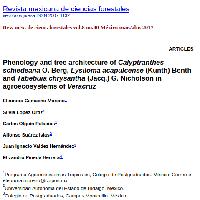Resumen
-
Se estudió la fenología y arquitectura de Calyptranthes schiedeana, Lysiloma acapulcense y Tabebuia chrysantha, especies de selva baja caducifolia, con importancia cultural y potencial para la agroforestería. Se seleccionaron 10 árboles de cada taxón dispersos dentro de agroecosistemas de veracruz, México; y se observó su fenología con una periodicidad de 14 días (febrero 2014-marzo 2015). Se registraron cambios en: 1) formación de yemas florales, 2) floración, 3) fructificación, 4) dispersión de semillas, 5) presencia, 6) caída, y 7) brote de hojas; los cuales se relacionaron con la temperatura y precipitación. En marzo del 2014 se evaluó la arquitectura arbórea y se definió el tipo de crecimiento. La fenología de los taxa correspondió con la característica de selva baja caducifolia; aunque L. acapulcense tendió a mantener hojas durante mayor tiempo y fructificar cuando la humedad en el suelo fue menor. C. schiedeana requirió de precipitación para desarrollar yemas foliares (r = 0.60, P = 0.0004); mientras que su formación en T. chrysantha dependió del descenso en la temperatura (r = 0.58, P = 0.0008). La fructificación en L. acapulcense fue disminuyendo con temperaturas bajas (r = -0.90, P < 0.0001), esta última también destacó por su copa situada a mayor altura (P < 0.0001 ), más grande (P < 0.0001) y con ramas más largas (P < 0.0001); además, adoptó el modelo de crecimiento Troll; T. chrysantha presentó el modelo Leeuwenberg y C. schiedeana el de Attims. Se concluye que las tres especies tienen distintos patrones fenológicos y modelos arquitectónicos, pero pueden adaptarse a sistemas agroforestales asociándolos a cultivos.
-
This paper describes a study of the phenology and tree architecture of Calyptranthes schiedeana, Lysiloma acapulcense and Tabebuia chrysantha, species of the low deciduous forest with a cultural importance and a potential for agroforestry. Ten trees of each of these taxa dispersed within the agroecosystems of veracruz, Mexico, were selected, and their phenology was observed every 14 days (from February 2014 to March 2015). Changes occurred in: 1) the development of floral buds, 2) flowering, 3) fruiting, 4) seed dispersal, 5) presence, 6) fall, and 7) shooting of leaves, all of them related to temperature and precipitation. In March 2014 the tree architecture was assessed, and the type of growth was determined. The phenology of the taxa was characteristic of the low deciduous forest, although L. acapulcense tended to keep its leaves for a longer time and to fruit with lower levels of soil moisture. C. schiedeana required precipitation in order to form leave buds (r = 0.60, P = 0.0004), while the development of these dependend on the decrease of temperature (r = 0.58, P = 0.0008). Fruiting in L. acapulcense diminished gradually with lower temperatures (r = -0.90, P < 0.0001); this species was also prominent for its higher, larger crown with longer branches; besides, it adopted the Troll growth model, while T. chrysantha exhibited the Leeuwenberg model, and C. schiedeana, the Attims model. It is concluded that the three species have different phenologic patterns and architectural models, but they can all adapt to agroforestry systems by being associated to crops.
